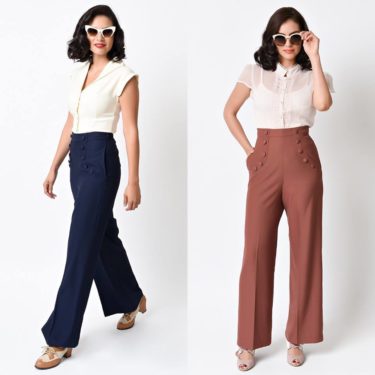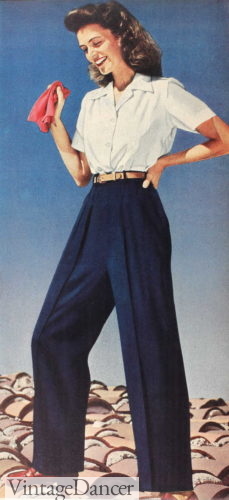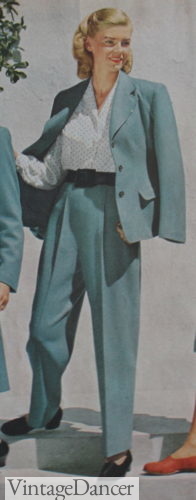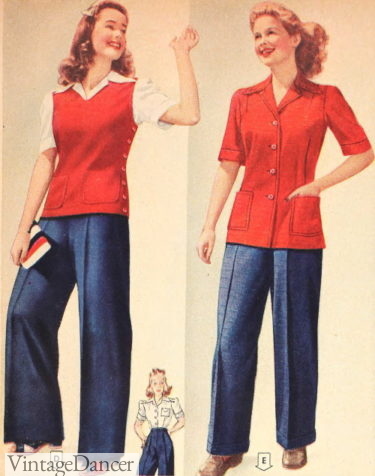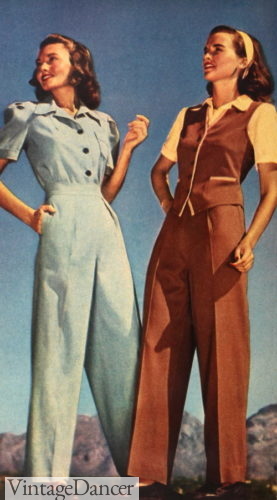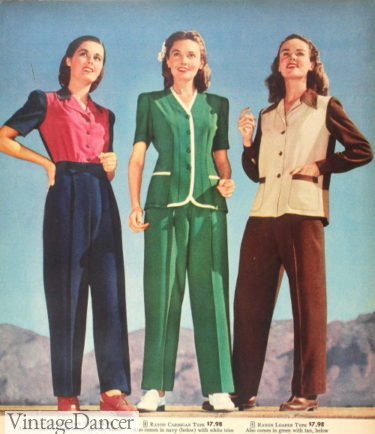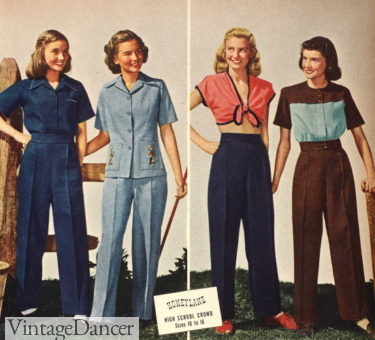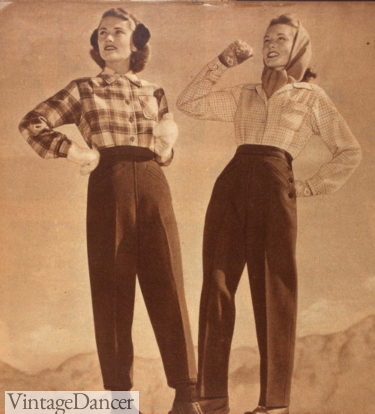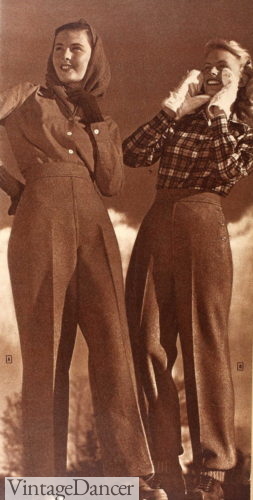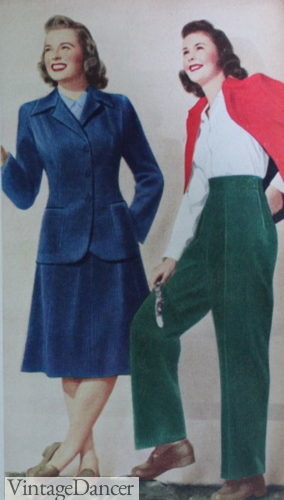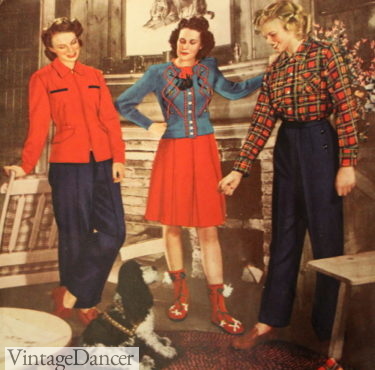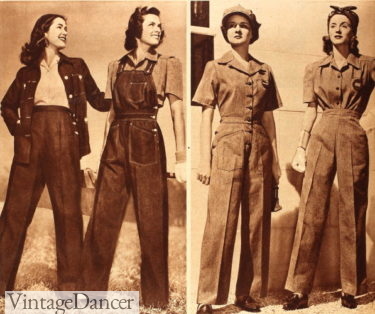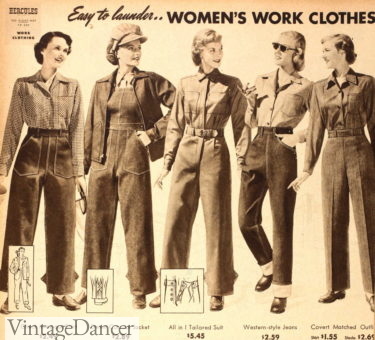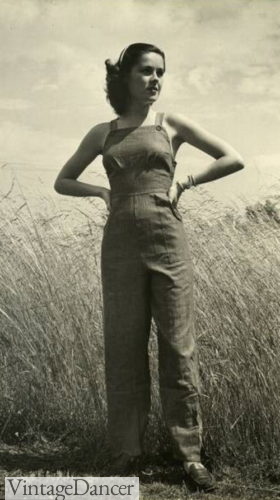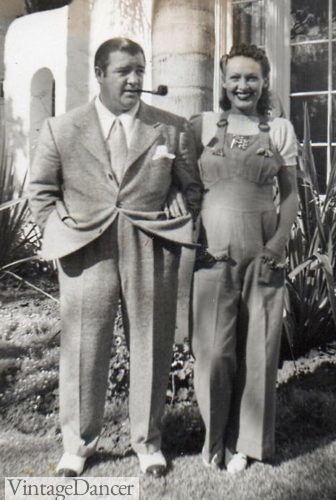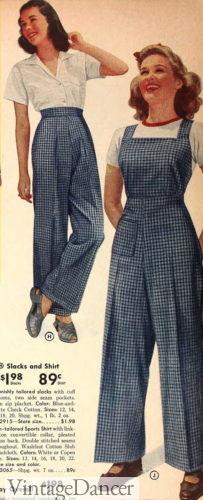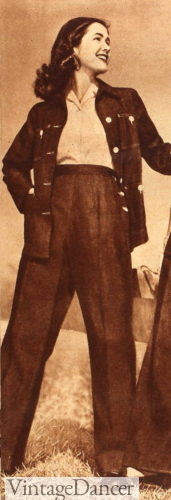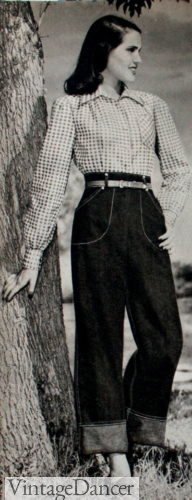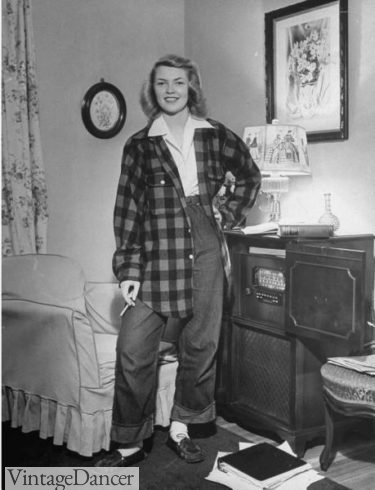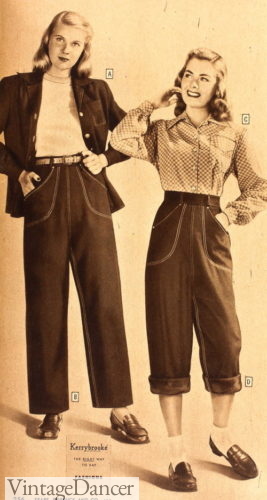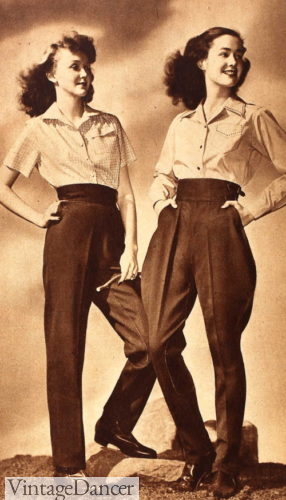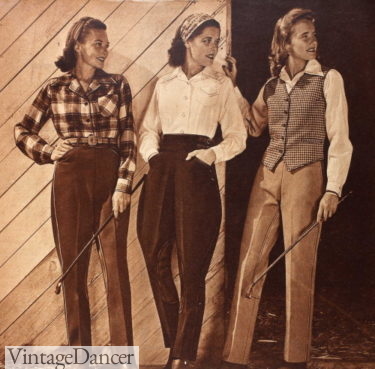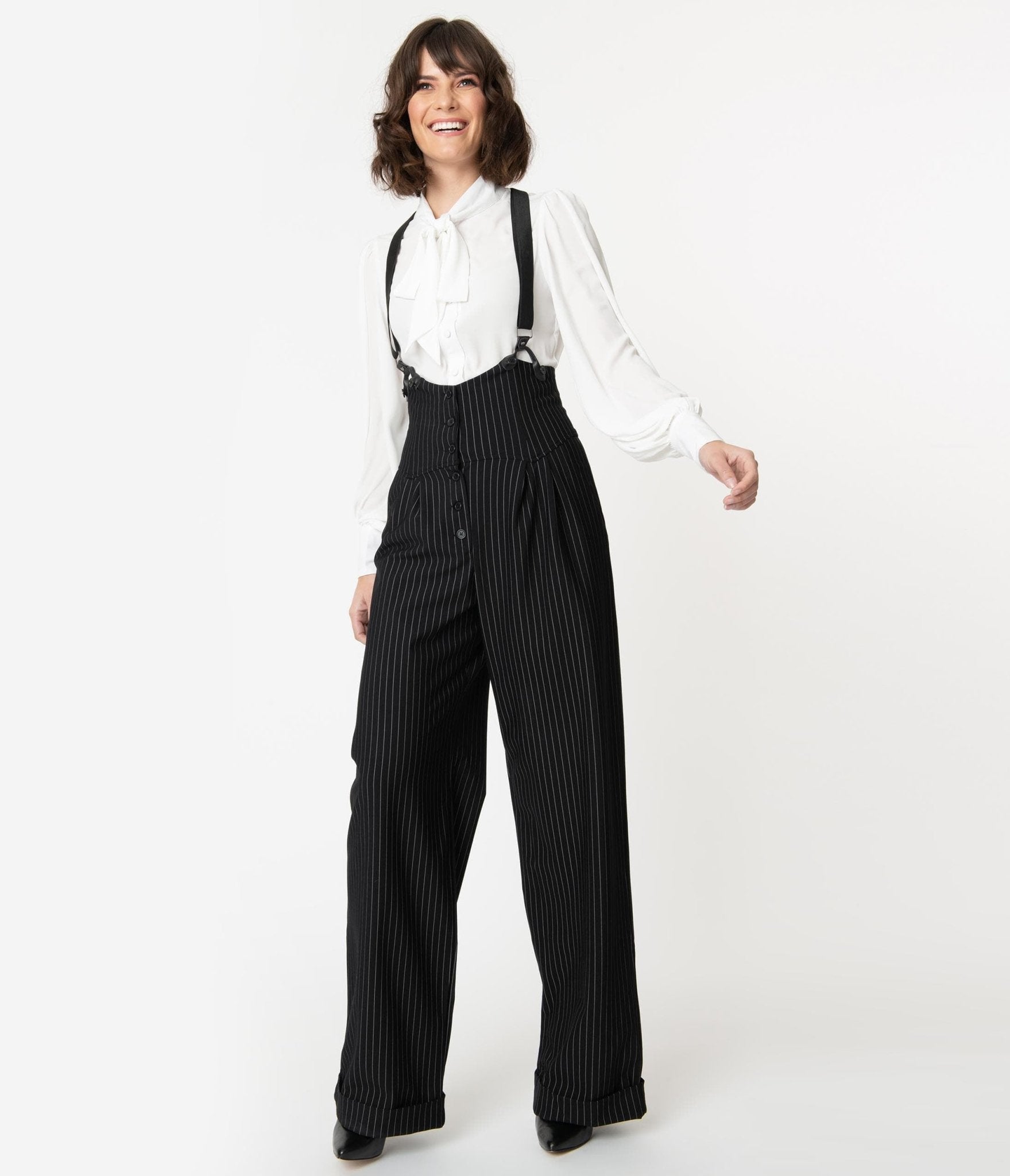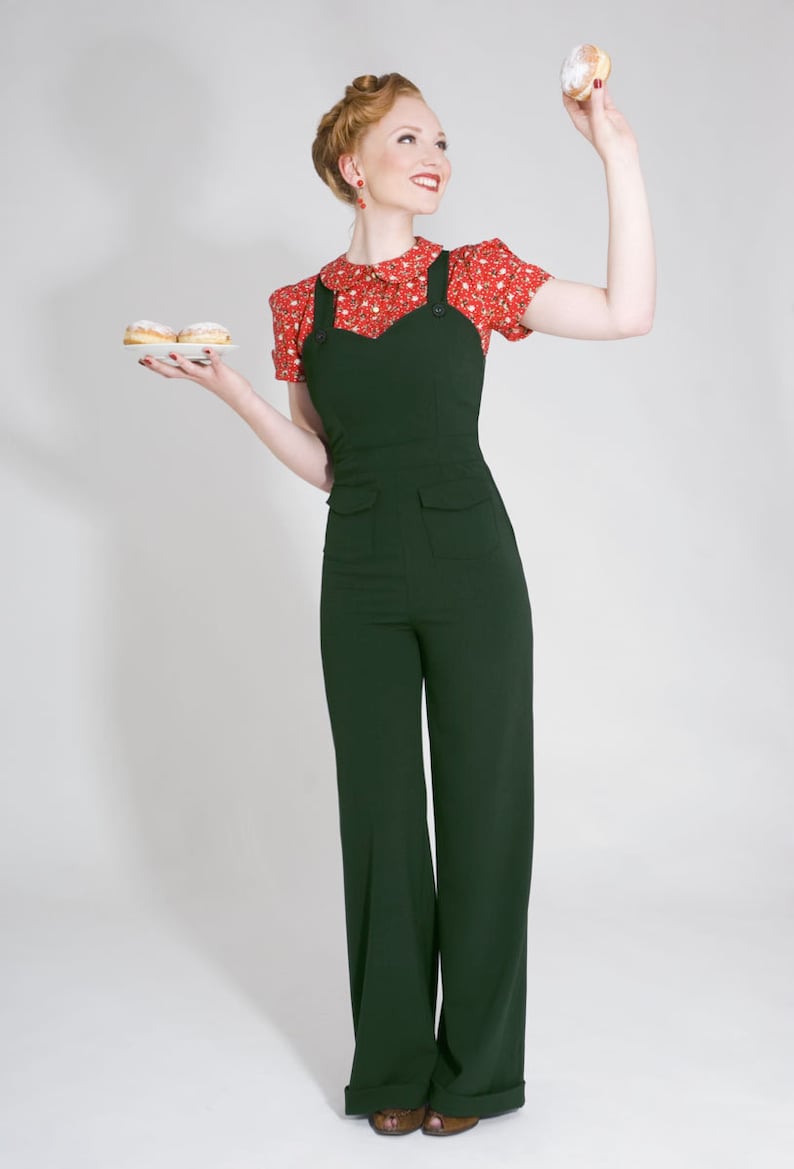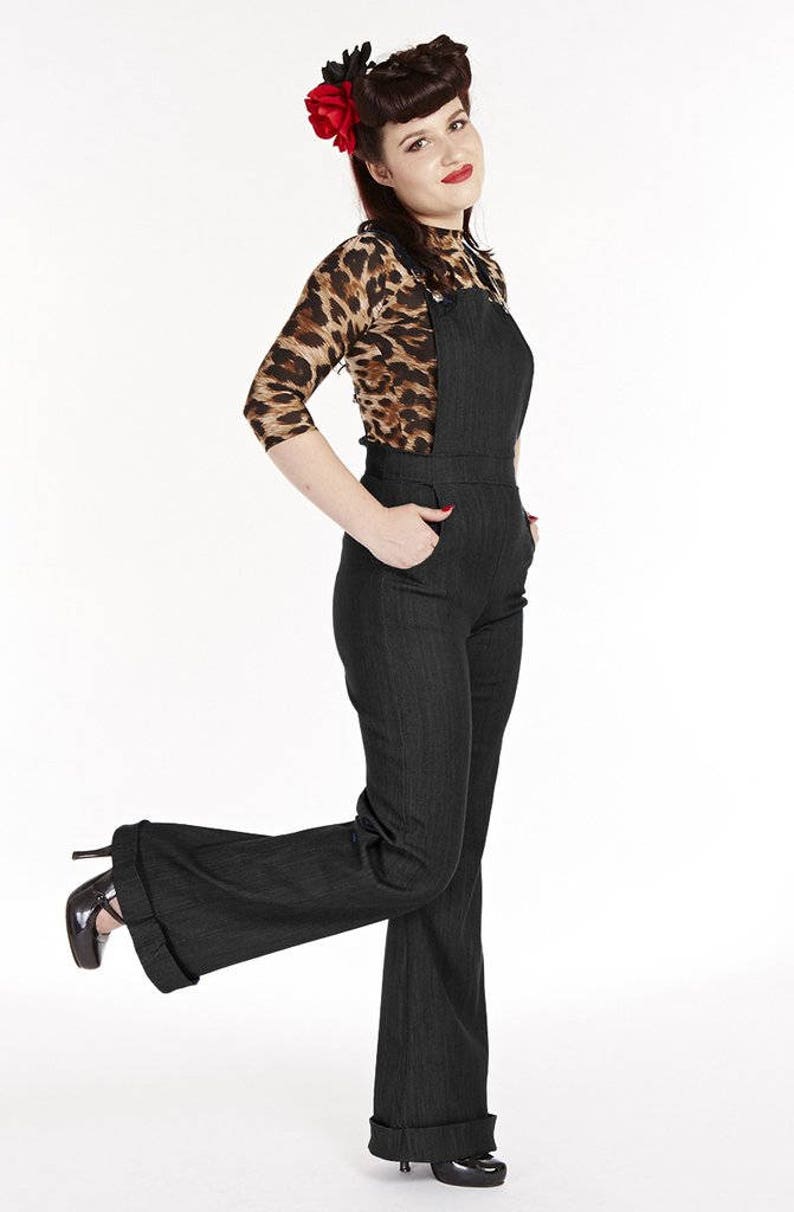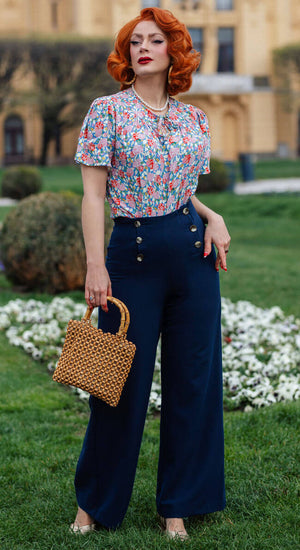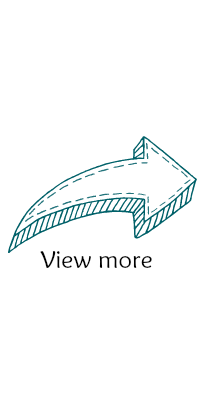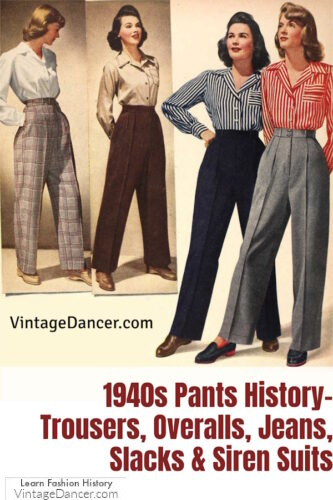
Before the 1940s, women simply did not wear pants / trousers /slacks as a normal part of their daily wardrobe. 1930s women’s loungewear included Beach Pajamas, overalls, culottes and sailor pants, but these were were only acceptable for at home, sport, work or vacationing activities.
Going into the 1940s, loungewear and workwear blended together to create the first decade of women’s trousers (called slacks), styled after menswear but with a definite women’s silhouette. Women’s 1940s pants found a new place in a turbulent decade.
Skip the 1940s pants history and shop for new 1940s style pants.
Women’s 1940s Pants History
It wasn’t until women began working in factories, doing traditional men’s work, that safety reasons required women to start wearing practical pants. At first they just had to make do with wearing men’s pants, but with a growing all-women workforce in the early 1940s, pants had to be designed for women as well.
Ladies 1940s pants were much easier to work in than a skirt or dress, especially in manufacturing jobs, where skirts could get caught in machinery and sitting in them proved to be less than modest. At first, 1930s pants were only publicly worn while working or lounging, but as the ’40s wore on, women began to wear pants as everyday attire for public day-wear.
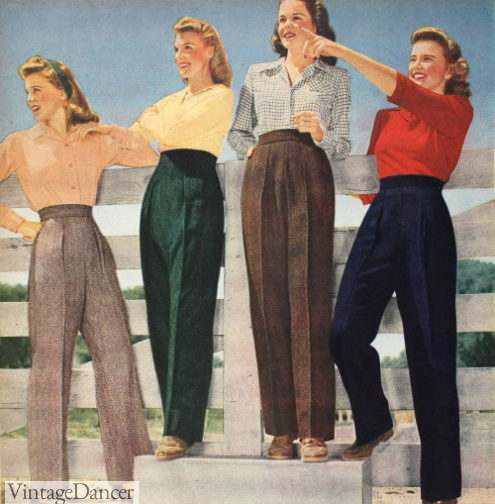
1943, Everyday Fashions Included Slacks and Button-Down Shirts
What were pants called in the 1940s? Women’s pants were called slacks.
At first, pants were worn freely by young women. Vogue magazine, which did not enjoy this new fashion, said, ” We deplore the crop of young women who take war as an excuse for.. parading about in slacks” (1939). Wide leg slacks hid the curves of women’s bodies – a form of beauty men needed to keep positive during tough times.
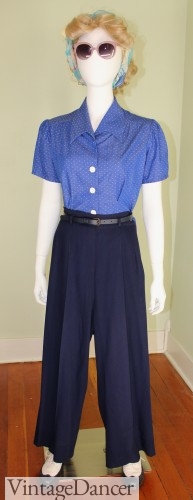
My vintage 1940s rayon pants- Create this look.
Women’s swing pants of the 1940s were not exactly figure-flattering. The design was basically the same as for a man’s pant, tailored and not meant for the female form. Pants sat at the natural waistline, well above the belly button. They were tight around the waist, with a wide waistband of about 2 to 2.5 inches. A thin leather belt was often worn in the middle of the wide waistband.
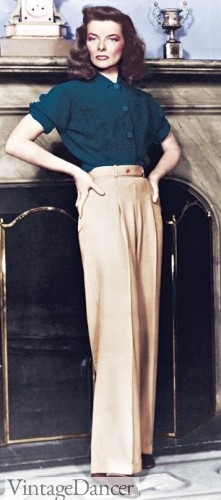
Katherine Hepburn 1940s wide flowing pleated pants
From the waistband they had straight, wide legs that fit very loosely around the body. A single pressed pleat down the front was common, just like on men’s trousers. Additional pleats were added to some after the war.
Women’s 40s pant legs were usually uncuffed with large slit pockets on the sides only. The average width at the knee was 22-24 inches. Legs tapered slightly around the ankle, becoming more and more tapered as the decade moved on.
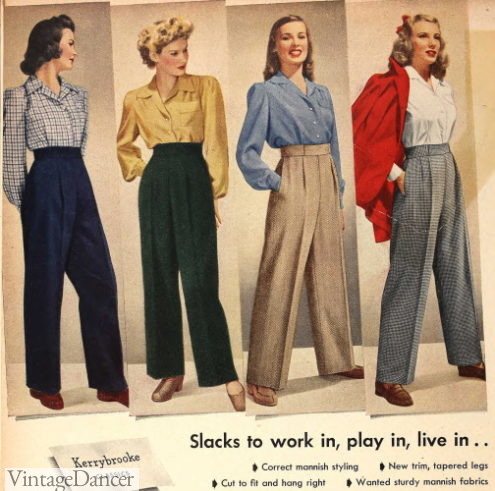
1942 “Slacks to Work In, Play In, Live In…”
What were pants made of in the 1940s?
Dressy and casual 40s pants were made of wool blends, rayon blends, wool flannel, gabardine, cotton corduroy, cotton twill, and seersucker in colors of black, blue, green, grey, and brown. Black and white or brown and white check patterns were very common throughout the 1940s. Some later ’40s trousers came in vertical stripes, plaids and large checks.
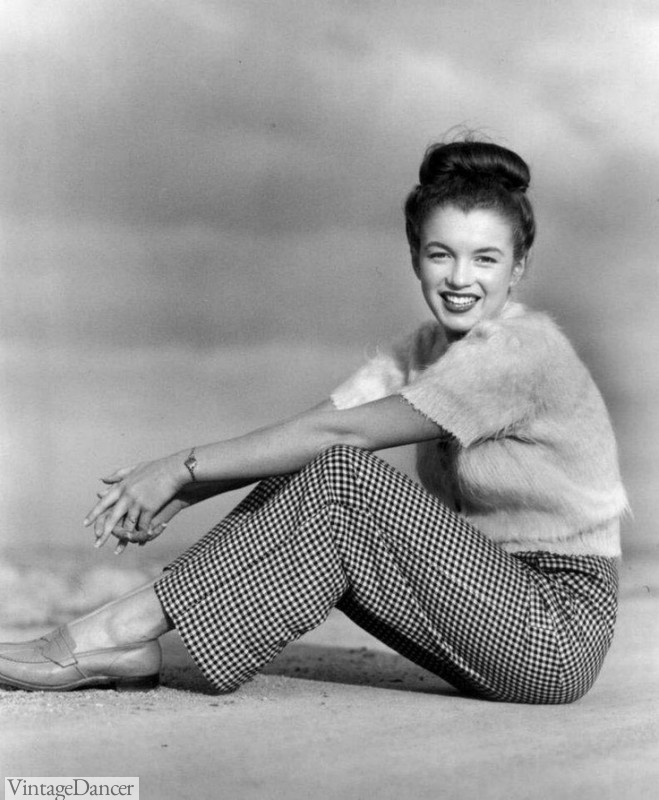
A Young Marilyn Monroe Wearing Check Houndstooth Pants and Loafers
Unlike men’s trousers, which buttoned up at the front fly, women’s pants were fixed at the sides with several buttons, and in the late 1940s with a side zipper. The reason for this was that a front fly on women was seen as too “manly” or “vulgar.” Since women were already buttoning up skirts and dresses on the side, making pants do the same was no issue.
- 1944 Navy Blue Pleated Slacks
- 1947 Aqua Blue Summer Slacks
In the 1940s women wearing slacks became common place during the day but not in the evenings. Some Hollywood starlets attempted to break the social rules and enter nightclubs wearing pants. They were turned away. That didn’t stop them from hosting house parties in their dressiest slacks and pretty blouses.
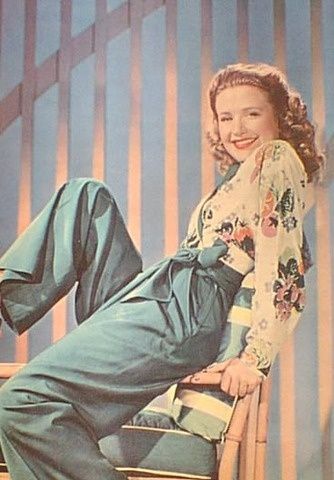
Priscilla Lane wears slacks with floral blouse
1940s Pantsuits
The blending of slacks with workwear and leisurewear was most prevalent in the creation of 1940s slacksuits (later called pantsuits). Slacksuits referred to any kind of matching pant and shirt, vest or jacket.
Because they were intended for home use and casual activities in warm weather, they could be freer in color selection. Pastel blue, pink, white, tan, as well as darker hues of emerald green, navy blue, and red all saw use.
- 1942 Teen’s Sleeveless Vest and Shirt-Jacket with Navy Blue Slacks
- 1943 Shirt-Jacket Slacksuits
- 1945 Shirt and Vest Slacksuits
Slacksuit / Pantsuit tops could be one of several styles:
1. A short sleeve button down shirt worn tucked into the waist.
2. A short or long sleeve shirt-jacket with two hip pockets worn untucked, often in two-tone color blocking (called the California style).
3. A cropped blouse with a tie knot.
4. A men’s style button down vest.
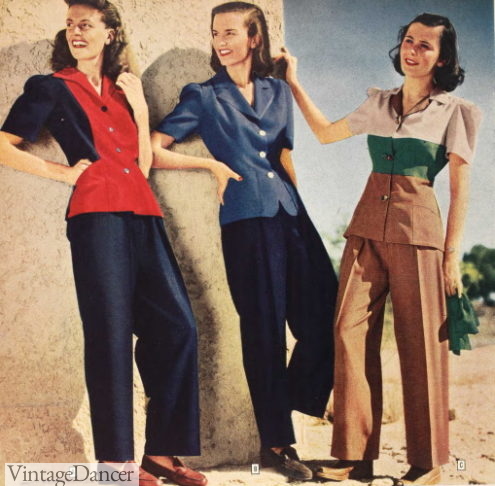
1943 “California style” Two-Tone Slacksuits
Although slacksuits were sold as a matching set, many women used them as separates, mixing pants and tops with blouses, knit T-shirts, sweaters, and light jackets for unlimited outfits.
- 1945 Shirt and Shirt-Jacket Slacksuits
- 1946 Casual Slacksuits and Playwear for Teens
1940s Winter Pants
In winter, especially very cold climates, women needed a pant that would keep her warm. Wool ski pants from the 1930s continued to be worn as winter pants, now with a optional straight leg with a hidden knit ankle cuff on the inside.
They were made of a heavy wool, lined in a soft flannel or brushed cotton. Brown, green, navy blue were the common colors.
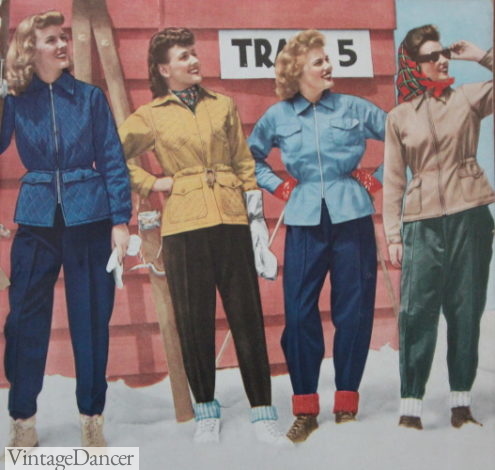
1943 ski pants and jackets
Ski pants had the same fit as women’s slacks but had a flat front, side buttons, back pocket, and center pressed leg seam.
- 1944 Ski or Winter Pants
- 1943 Ski or Winter Pants
Besides wool ski pants, women indoors or in milder winter climates could wear corduroy pants or dressy wool slacks. See more fall and winter 1940s outfit ideas here.
- 1942 corduroy winter outfits
- 1944 Winter Outfits with Wool Pants
1940s Workwear: Pants, Overalls & Coveralls
Coveralls
The other style of women’s pants of the 1940s were the famous Rosie the Riveter coveralls.
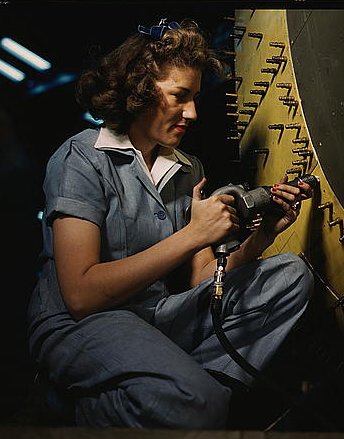
A Real Rosie Wearing Coveralls
These were usually made of blue denim or heavyweight cotton canvas in brown, tan, or blue. The coveralls buttoned down the front middle to get in and out of, and were loose-fitting throughout.
They often had breast pockets to keep pens and small tools in. Both the long shirt sleeves and pants cuffs were tied tight around the wrists and ankles to keep them from being caught in heavy machinery.
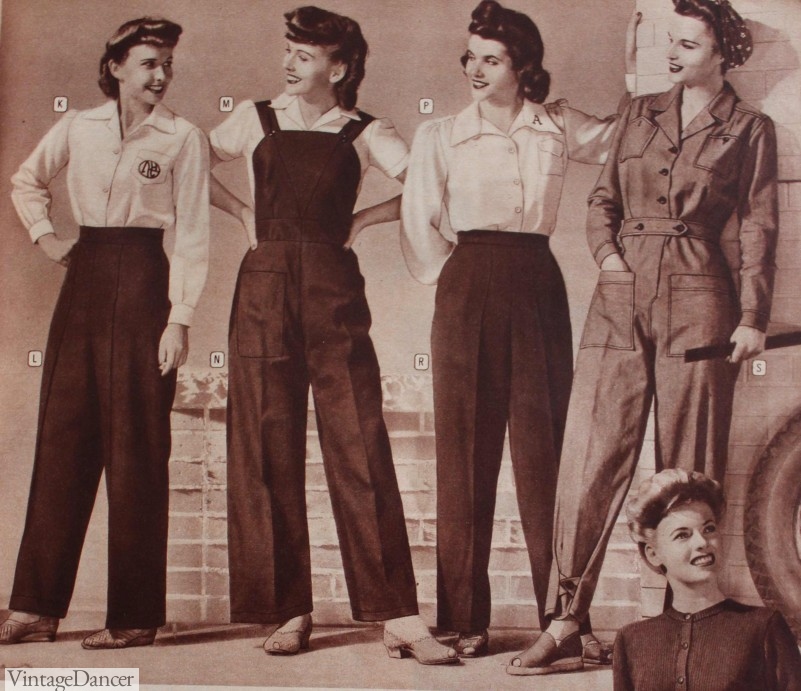
1943 Working Pants, Overalls, and Coveralls
Jumpsuits
Jumpsuits or ‘siren suits’, similar to coveralls, served another use during the war. Made of a soft flannel or lighter cotton, they were an ideal clothing item to wear over pajamas or a nightgown in case one needed to change quickly during an air raid.
They zipped up the front to make them easy to put on, cuffed around the ankle, and came with hoodies to cover up hair. Hooded capes and coats were an even quicker coverup for air raids.
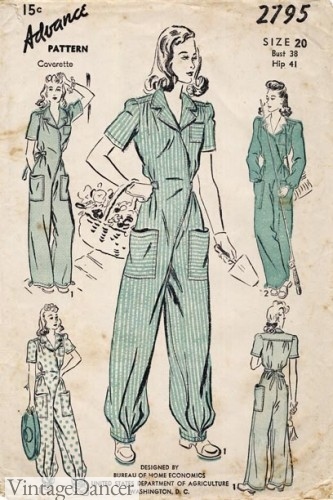
Jumpsuit Pattern “Coverette”
Overalls
Women’s 1940s overalls featured a bib front or two suspender-like straps that held up the pants, which were called pinafore style pants. Large slit pockets or a patch pocket on the front provided yet another place to hold things. Similar to play overalls, they were made of heavy denim, but with the same fitted design of the 1930s.
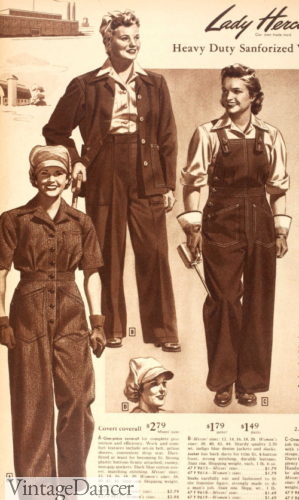
1943 Heavy Duty Coveralls, Pants, and Overalls
Extra large pockets, often called Kangaroo pockets, appeared on some trousers and overalls. The size of the pocket meant women could put more things in them quickly and have their hands free to carry children to safety or hold tools on the job. A multitasking woman in the 1940s saw practicality as more important than fashion.
Learn more about 1940s women’s workwear.
- 1943 Pants, Overalls, and Coveralls
- 1949 Workwear Outfits
After the war, women returned to their playtime overalls made of softer fabrics. In summer, teens wore their overalls without a shirt underneath. Otherwise, women wore a knit T-shirt or button up blouse with their overalls.
The bibs on these overalls took on the Pinafore shape with modest sweetheart or squared neck coverage around the bust to the back, only exposing the neck and shoulders.
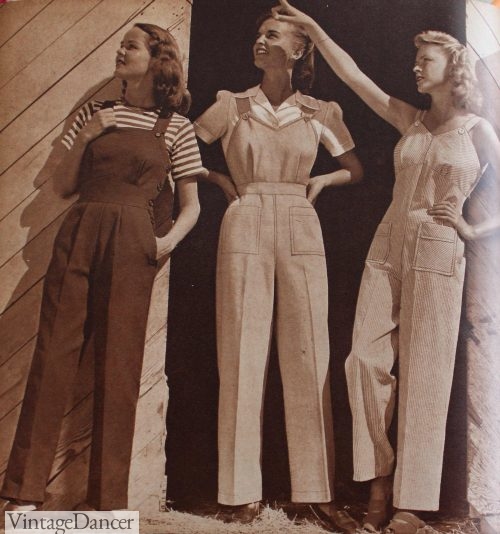
1944 Casual Overalls Paired with a Striped T-Shirt, a White Blouse, and No Shirt (Gasp!)
New materials were also introduced, such as rayon or other synthetics, cotton twill, and chambray. Lighter tans and greys, solids, and stripes were part of these revived fashions, although the classic navy blue with white buttons never went out of style.
Learn more about the history of women’s overalls.
Women’s 1940s Blue Jeans
Did women wear jeans in the 40s?
1940s blue jeans, called dungarees, were a necessary clothing item for laborious tasks. WWII made blue jeans more popular as working Rosies took to factories and Land Girls worked farms.
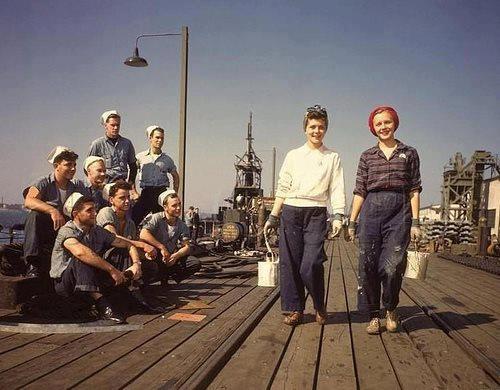
Working Rosies in Men’s Blue Jeans
Men’s blue jeans had a loose fit, long crotch, and a wide rolled cuff. Women’s cut jeans had a slightly narrowed leg (that was still rather boxy), curved hip, and a side zipper. Some women’s versions had white buttons on the side. Others had contrast stitching around deep pockets.
- 1943 denim jeans with white side buttons
- 1942 denim slacks pants
- 1947 Contrast Stitching Jeans
There were two big blue jeans brands in the 1940s: Levi’s and Lee. When Wrangler tried to enter the market, they turned to Rodeo, a growing entertainment sport to get the word out. Rodeo stars had near-Hollywood status — and it wasn’t just the cowboys. Women competed and won wearing Wrangler Jeans with its signature logo on the back pockets.
There were singing cowgirls too – entertainers on TV singing country ballads wearing a variety of Western dresses and blue jeans. Regular country folk wore blue jeans more often than city slickers, who only wore them while on vacation to Dude Ranches.
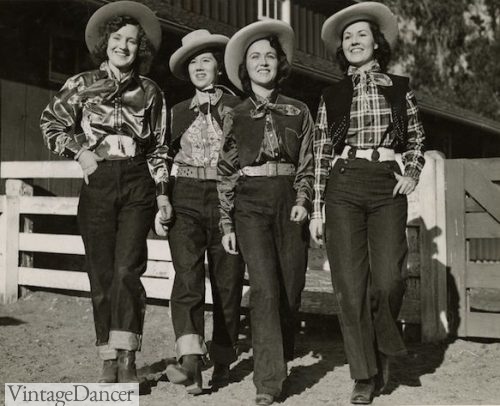
1940s Levis Jeans for Women Ad
Western style blue jeans had a narrowed tapered leg, flat front with a seam, room for a western style belt, and cuffed or plain hem.

1948 Western Style Jeans (Wrangler Style)
In 1948, Wrangler invented the front zip up jeans for women. Women didn’t like the new front zip, at least not until the 1950s.
Learn more about the history of blue jeans here and western clothing here.
More Denim Jeans
It was the 1940s American teenager who adopted men’s jeans and made it part of her casual wardrobe, even in the city. She paired them with men’s button down shirts with rolled up sleeves, rolled pant cuffs, and a leather belt. Hmmm, isn’t this the same “boyfriend” fashion we have today? Yes, yes it is.
The rolled cuff jeans style continued well into the 1950s, mostly among teenagers but for women as well.
- 1944 Teen Wearing Men’s Jeans and Oversized Shirt
- 1949 Check Shirt and Rolled Cuff Jeans
- 1947 Teen Jeans, Long and Rolled Cuff
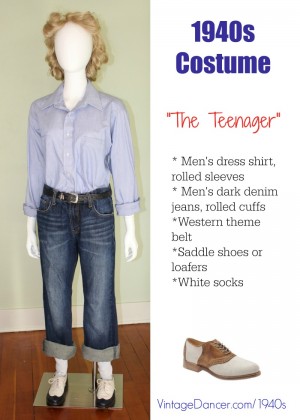
1940s Casual Teenager Costume: Denim rolled jeans, men’s button down shirt, saddle shoes
Riding Jodhpurs
One unique kind of pant was the riding pant, called saddle pants, or their cousin the jodhpurs. Women who rode horses, hiked, worked outdoors, or lived in the country were frequent wearers of riding pants both on the ranch and in town.
Jodhpurs are the funny pants with the wide thighs, an extra wide waistband, and a narrow long leg with inside saddle patches.
Saddle pants were long and slender pants with inside knee patches. They could be shaped like slacks or western jeans.
As the decade moved into the 1950s, the pants continued to slim down in the hip and thigh. Wool was replaced by cotton twill and saddle patches almost disappeared.
- 1943 Riding Pants and Jodhpurs
- 1944 Riding Outfits
Read More
- 1930s Women’s Trousers History
- 1950s Pants Styles for Women
- Teenage Fashion in the 1940s – Girls
- 1940s Women’s Blouse and Top Styles
- 1940s Ladies’ Workwear Clothes
Research Sources
Forties Fashion: From Siren Suits to the New Look by Jonathan Walford
Fashion from Victoria to the New Millennium by Daniel Dellis Hill
1940s Sears, Montgomery Wards clothing catalogs.
Shop 1940s Style Pants
Nearly any wide leg pant with a high natural waist line will give you an instant 1940s look. There are handful of brands making reproduction 1940s dress slacks, overalls, and blue jeans. Winter pants are much harder to find. Here are some good options currently on the 1940s style pants shop page.
You can also sew a pair with one of these patterns.
